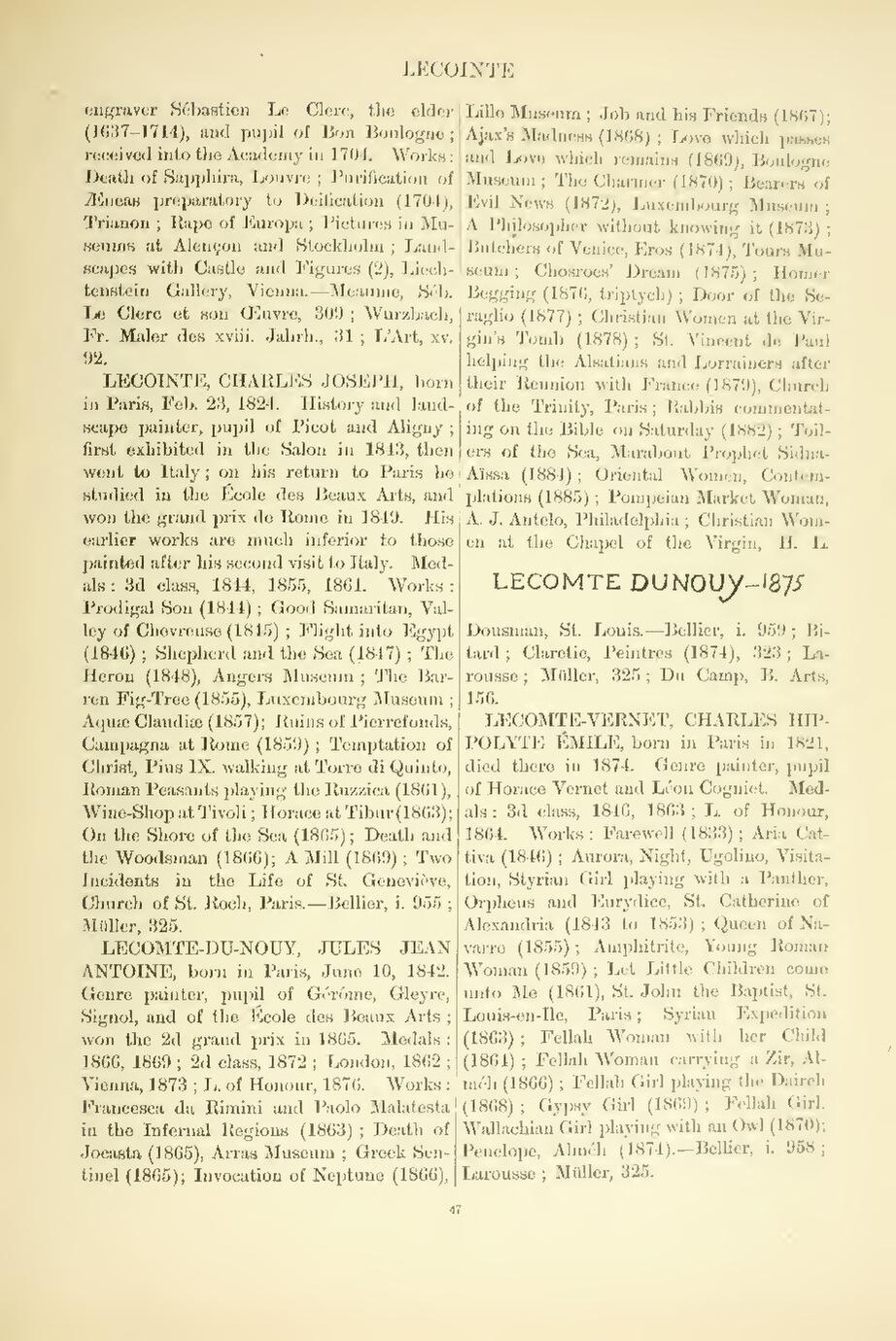engraver Sébastien Le Clerc, the elder (1637-1714), and pupil of Bon Boulogne; received into the Academy in 1704. Works: Death of Sapphira, Louvre; Purification of Æneas preparatory to Deification (1704), Trianon; Rape of Europa; Pictures in Museums at Alençon and Stockholm; Landscapes with Castle and Figures (2), Liechtenstein Gallery, Vienna.—Meaume, Séb. Le Clerc et son Œuvre, 309; Wurzbach, Fr. Maler des xviii. Jahrh., 31; L'Art, xv. 92.
LECOINTE, CHARLES JOSEPH, born
in Paris, Feb. 23, 1824. History and landscape
painter, pupil of Picot and Aligny;
first exhibited in the Salon in 1843, then
went to Italy; on his return to Paris he
studied in the École des Beaux Arts, and
won the grand prix de Rome in 1849. His
earlier works are much inferior to those
painted after his second visit to Italy. Medals:
3d class, 1844, 1855, 1861. Works:
Prodigal Son (1844); Good Samaritan, Valley
of Chevreuse (1845); Flight into Egypt
(1846); Shepherd and the Sea (1847); The
Heron (1848), Angers Museum; The Barren
Fig-Tree (1855), Luxembourg Museum;
Aquæ Claudiæ (1857); Ruins of Pierrefonds,
Campagna at Rome (1859); Temptation of
Christ, Pius IX. walking at Torre di Quinto,
Roman Peasants playing the Ruzzica (1861),
Wine-Shop at Tivoli; Horace at Tibur (1863);
On the Shore of the Sea (1865); Death and
the Woodsman (1866); A Mill (1869); Two
Incidents in the Life of St. Geneviève,
Church of St. Roch, Paris.—Bellier, i. 955;
Müller, 325.
LECOMTE-DU-NOUY, JULES JEAN
ANTOINE, born in Paris, June 10, 1842.
Genre painter, pupil of Gérôme, Gleyre,
Signol, and of the École des Beaux Arts;
won the 2d grand prix in 1865. Medals:
1866, 1869; 2d class, 1872; London, 1862;
Vienna, 1873; L. of Honour, 1876. Works:
Francesca da Rimini and Paolo Malatesta
in the Infernal Regions (1863); Death of
Jocasta (1865), Arras Museum; Greek Sentinel
(1865); Invocation of Neptune (1866),
Lille Museum; Job and his Friends (1867);
Ajax's Madness (1868); Love which passes
and Love which remains (1869), Boulogne
Museum; The Charmer (1870); Bearers of
Evil News (1872), Luxembourg Museum;
A Philosopher without knowing it (1873);
Butchers of Venice, Eros (1874), Tours Museum;
Chosroes' Dream (1875); Homer
Begging (1876, triptych); Door of the Seraglio
(1877); Christian Women at the Virgin's
Tomb (1878); St. Vincent de Paul
helping the Alsatians and Lorrainers after
their Reunion with France (1879), Church
of the Trinity, Paris; Rabbis commentating
on the Bible on Saturday (1882); Toilers
of the Sea, Marabout Prophet Sidna-Aïssa
(1884); Oriental Women, Contemplations
(1885); Pompeian Market Woman,
A. J. Antelo, Philadelphia; Christian Women
at the Chapel of the Virgin, H. L.
Dousman, St. Louis.—Bellier, i. 959; Bitard;
Claretie, Peintres (1874), 323; Larousse;
Müller, 325; Du Camp, B. Arts,
156.
An image should appear at this position in the text. To use the entire page scan as a placeholder, edit this page and replace "{{missing image}}" with "{{raw image|Cyclopedia of painters and paintings (IA cyclopediaofpain03cham).pdf/69}}". Otherwise, if you are able to provide the image then please do so. For guidance, see Wikisource:Image guidelines and Help:Adding images. |
LECOMTE-VERNET, CHARLES HIPPOLYTE ÉMILE, born in Paris in 1821, died there in 1874. Genre painter, pupil of Horace Vernet and Léon Cogniet. Medals: 3d class, 1846, 1863; L. of Honour, 1864. Works: Farewell (1833); Aria Cattiva (1846); Aurora, Night, Ugolino, Visitation, Styrian Girl playing with a Panther, Orpheus and Eurydice, St. Catherine of Alexandria (1843 to 1853); Queen of Navarre (1855); Amphitrite, Young Roman Woman (1859); Let Little Children come unto Me (1861), St. John the Baptist, St. Louis-en-Ile, Paris; Syrian Expedition (1863); Fellah Woman with her Child (1864); Fellah Woman carrying a Zir, Alméh (1866); Fellah Girl playing the Daireh (1868); Gypsy Girl (1869); Fellah Girl, Wallachian Girl playing with an Owl (1870); Penelope, Alméh (1874).—Bellier, i. 958; Larousse; Müller, 325.
